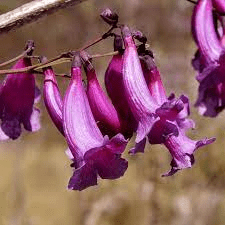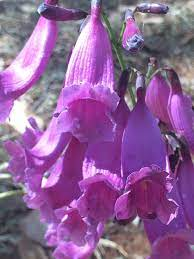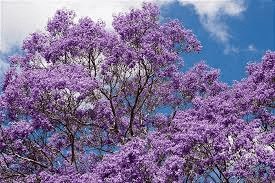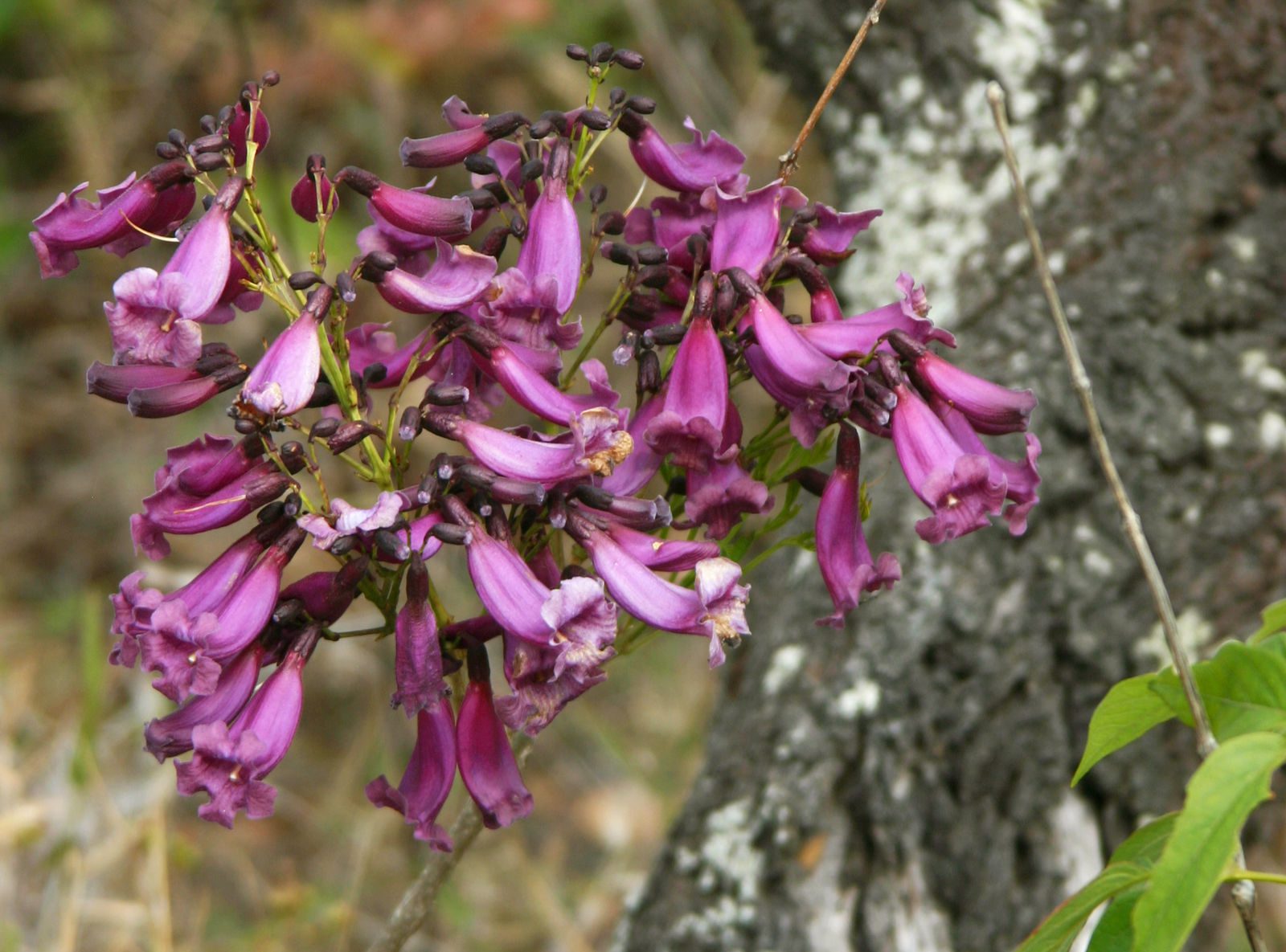Jacaranda caroba, commonly known as Caroba, is a flowering tree native to Brazil, particularly prevalent in the Atlantic Forest region. This evergreen tree, belonging to the Bignoniaceae family, is valued for its medicinal properties and has a history deeply rooted in traditional Brazilian herbal medicine.
Caroba is characterized by its pinnate leaves and striking tubular flowers. The tree can reach considerable heights, and its compound leaves consist of smaller leaflets with serrated edges. The flowers, which appear in clusters, vary in color from pale lavender to purple, creating a visually appealing display when in bloom.
In traditional Brazilian folk medicine, various parts of the Caroba tree, including the leaves, bark, and roots, are utilized for their therapeutic benefits. The plant is particularly renowned for its anti-inflammatory properties and has been traditionally employed to alleviate conditions such as arthritis and rheumatism.
The leaves of Caroba are often prepared as infusions or decoctions to create herbal teas, which are believed to have potential benefits for digestion and respiratory health. The bark and roots may also be used in traditional remedies, reflecting the plant’s versatility in traditional healing practices.
Beyond its medicinal uses, Caroba has ecological significance as a native species in the Atlantic Forest, contributing to the biodiversity of this rich and endangered ecosystem. Efforts to conserve and sustainably use Caroba align with broader initiatives aimed at preserving the unique flora of the region.
While Caroba may not be as widely known on the global stage as some other medicinal plants, its importance in traditional Brazilian medicine and its ecological role make it a valuable and culturally significant species.
As interest in herbal remedies and sustainable practices continues to grow, plants like Jacaranda caroba contribute to the rich tapestry of botanical knowledge and conservation efforts.
The Botanical Description of Jacaranda caroba
1. Morphology: Jacaranda caroba, commonly known as caroba, is a deciduous tree belonging to the Bignoniaceae family. It is characterized by its medium to large size, reaching heights of 15 to 25 meters. The tree typically features a straight trunk with a well-defined, spreading crown.
2. Leaves: The leaves of Jacaranda caroba are compound and pinnate, arranged in an opposite pattern along the branches. Each leaf is composed of several leaflets, usually ranging from 5 to 7 in number. The leaflets have a lanceolate shape with serrated margins, giving the foliage an elegant appearance.
3. Flowers: Caroba is renowned for its stunning and vibrant flowers. The trumpet-shaped blooms form large, conspicuous clusters, creating a spectacular display during the flowering season. The color palette includes shades of lavender, violet, and sometimes blue, adding to the tree’s ornamental value.
4. Inflorescence: The inflorescence of Jacaranda caroba is typically terminal, arising at the ends of branches. The arrangement of flowers in dense clusters contributes to the tree’s visual appeal and makes it a sought-after ornamental species.
5. Bark: The bark of caroba is relatively smooth and grayish-brown when young, gradually developing a rougher texture with age. The bark’s color and texture contribute to the overall aesthetics of the tree’s trunk.
6. Fruit: The fruit of Jacaranda caroba is a woody capsule containing numerous small, winged seeds. These capsules are often elongated and can reach lengths of 15 to 30 centimeters. As the capsules mature, they split open, releasing the seeds for dispersal.
7. Growth Habit: Caroba exhibits an upright and symmetrical growth habit, creating a well-balanced and visually pleasing silhouette. The tree’s form makes it a popular choice in urban landscaping and public spaces.
8. Seasonal Changes: Jacaranda caroba undergoes distinct seasonal changes. In regions with a marked dry season, the tree sheds its leaves during the dry period and regains foliage with the onset of the wet season. This cyclical pattern is essential for the tree’s adaptation to its environment.
9. Root System: The root system of caroba is generally shallow but expansive, spreading out to anchor the tree and extract nutrients from the surrounding soil. This root architecture supports the tree’s stability and growth.
10. Ornamental Value: Beyond its natural habitat, Jacaranda caroba is widely cultivated for its ornamental value. The vibrant flowers, combined with the tree’s overall aesthetic appeal, make it a popular choice in parks, gardens, and along streets.
The Geographic Distribution of Jacaranda caroba

1. Native Range: Jacaranda caroba is native to South America, with its natural range extending across countries such as Brazil, Argentina, and Paraguay. Within this region, it thrives in diverse ecosystems, from tropical rainforests to subtropical areas.
2. Introduction to Other Regions: Due to its ornamental and aesthetic qualities, Jacaranda caroba has been introduced to various regions outside its native range. It is now cultivated in parts of North America, Asia, and Africa, where climatic conditions permit its growth.
3. Climate Preferences: Caroba prefers tropical to subtropical climates with well-defined wet and dry seasons. It thrives in regions with annual rainfall and temperatures conducive to its growth and flowering.
4. Soil Adaptability: The adaptability of Jacaranda caroba to different soil types contributes to its widespread distribution. It can grow in well-drained soils with various textures, from sandy to loamy, as long as the soil allows for proper root development.
5. Urban Landscaping: Beyond its natural habitat, caroba has found a place in urban landscaping. Many cities, especially in tropical and subtropical zones, feature avenues lined with Jacaranda caroba, enhancing the visual appeal of the urban environment.
6. Altitude Range: Jacaranda caroba is often found at elevations ranging from sea level up to 1,500 meters. This altitudinal range showcases its adaptability to different elevations within its preferred climate zones.
7. Affinity for Riverbanks: In its native habitat, caroba displays an affinity for riverbanks and areas with access to water. This ecological preference aligns with its role in riparian ecosystems and its ability to tolerate periodic flooding.
8. Ecological Importance: The distribution of Jacaranda caroba contributes to the ecological diversity of the regions it inhabits. Its presence influences local ecosystems and may provide habitat and food sources for various fauna.
9. Conservation Considerations: While not currently listed as endangered, conservation considerations are crucial due to factors such as habitat loss and urban development. Sustainable cultivation and conservation efforts are essential for maintaining caroba populations.
10. Horticultural Significance: Jacaranda caroba’s geographical distribution is not only a result of its natural habitat but also the intentional cultivation for its ornamental value. Its popularity in horticulture has contributed to its presence in diverse regions globally.
The Chemical Composition of Jacaranda caroba
1. Flavonoids: Jacaranda caroba is known to contain various flavonoids, including quercetin and kaempferol. These compounds contribute to the tree’s antioxidant properties and may have potential health benefits.
2. Triterpenoids: Triterpenoids are present in the bark and leaves of Jacaranda caroba. These compounds have been studied for their pharmacological properties, including anti-inflammatory and antimicrobial effects.
3. Alkaloids: Some alkaloids have been identified in Jacaranda caroba, although their specific types and concentrations may vary. Alkaloids can have diverse physiological effects and are often studied for their potential pharmacological applications.
4. Essential Oils: The leaves and flowers of caroba contain essential oils with aromatic compounds. These oils contribute to the tree’s fragrance and may have applications in perfumery or traditional medicine.
5. Phenolic Compounds: Jacaranda caroba contains phenolic compounds, including phenolic acids. These compounds are associated with antioxidant activity and may play a role in the tree’s defense mechanisms.
6. Saponins: Saponins, natural compounds with soap-like properties, are present in Jacaranda caroba. Research has explored the potential biological activities of saponins, including their antimicrobial and anti-inflammatory effects.
7. Steroids: Steroids are among the chemical constituents identified in caroba. These compounds are known for their diverse biological activities and may contribute to the tree’s pharmacological profile.
8. Lignans: Lignans, plant compounds with antioxidant properties, have been identified in Jacaranda caroba. These compounds are part of the complex chemical composition that contributes to the tree’s overall health-promoting potential.
9. Polyphenols: The presence of polyphenols in Jacaranda caroba adds to its antioxidant capacity. Polyphenols are studied for their role in preventing oxidative stress and promoting overall well-being.
10. Resins and Gums: Resins and gums are found in various parts of the caroba tree. These substances may play a role in wound healing and protection against pathogens, contributing to the tree’s resilience.
Read Also: How To Grow, Use and Care For Threespike Goosegrass (Eleusine Tristachya)
The Medicinal Health Benefits Of Jacaranda caroba (Caroba)

1. Anti-Inflammatory Properties: Caroba is known for its anti-inflammatory effects, attributed to compounds such as triterpenoids. These properties may be beneficial in managing inflammatory conditions, providing relief to individuals with issues like arthritis or inflammatory skin conditions.
2. Respiratory Health: The medicinal benefits of caroba extend to respiratory health. Its use has been associated with alleviating respiratory symptoms, making it a potential remedy for conditions such as asthma, bronchitis, or coughs.
3. Antioxidant Action: Rich in flavonoids and polyphenols, caroba exhibits antioxidant properties. Antioxidants play a crucial role in neutralizing free radicals in the body, contributing to overall cellular health and potentially reducing the risk of chronic diseases.
4. Gastrointestinal Support: Traditional uses of caroba include addressing gastrointestinal discomfort. Its properties may aid in soothing digestive issues, making it a part of traditional remedies for conditions like indigestion or mild stomach upset.
5. Wound Healing: Caroba has been traditionally employed for its potential wound-healing properties. Applying caroba-infused formulations may promote the healing process and protect against infections.
6. Calming Effects: Some users report calming effects associated with caroba consumption. This attribute may be linked to certain compounds in the plant, making it a consideration for individuals dealing with stress or mild anxiety.
7. Anti-microbial Activity: The plant’s chemical composition includes compounds with antimicrobial properties. Caroba may have potential in combating certain types of bacteria or fungi, contributing to its traditional use in addressing infections.
8. Diuretic Effects: Caroba has been recognized for its diuretic effects, promoting increased urine production. This property may be beneficial for individuals dealing with mild fluid retention or seeking to support kidney function.
9. Anti-Rheumatic Potential: Traditional medicine attributes anti-rheumatic properties to caroba. This suggests its potential role in managing conditions related to joint pain or discomfort.
10. Liver Support: Some traditional uses of caroba involve supporting liver function. The plant’s compounds may contribute to liver health, although more research is needed to fully understand this aspect.
11. Cardiovascular Health: Preliminary studies suggest that caroba may have positive effects on cardiovascular health. Its antioxidant and anti-inflammatory properties could contribute to maintaining a healthy cardiovascular system.
12. Antipyretic Effects: Caroba has been traditionally used to address fevers, showcasing antipyretic properties. This may be attributed to its ability to help regulate body temperature during fever episodes.
Methods of Usage to Achieve the Provided Health Benefits Of Jacaranda caroba (Caroba)
1. Infusions and Teas: One common method of utilizing caroba for its medicinal benefits is by preparing infusions or teas. Dried leaves or flowers can be steeped in hot water, creating a beverage that may be consumed for respiratory, anti-inflammatory, or calming effects.
2. Topical Applications: For wound healing and skin-related benefits, caroba can be incorporated into topical applications. Ointments, creams, or poultices infused with caroba extracts may be applied to the affected areas.
3. Dietary Supplements: Caroba extracts are available in various forms, including capsules or tinctures. These supplements provide a convenient way to incorporate the plant’s benefits into one’s routine, especially for those seeking antioxidant or anti-inflammatory support.
4. Steam Inhalation: Individuals seeking respiratory health benefits can consider steam inhalation. Adding caroba leaves or extracts to hot water and inhaling the steam may help address respiratory issues.
5. Culinary Uses: In regions where caroba is part of traditional cuisine, incorporating it into meals may offer subtle health benefits. However, it’s essential to consider the quantity consumed and the specific preparation methods to retain its medicinal properties.
6. Tinctures and Extracts: Liquid extracts or tinctures of caroba can be used for precise dosage and easy integration into various applications. These concentrated forms may be suitable for individuals looking to harness specific medicinal properties.
7. Traditional Formulations: In regions with a history of traditional medicine, practitioners may have specific formulations and recipes that include caroba. These formulations often consider synergistic effects with other herbs for comprehensive health benefits.
8. Aromatherapy: The aromatic compounds present in caroba may lend themselves to aromatherapy. Essential oils derived from caroba can be diffused or used topically (with carrier oils) for potential calming effects.
9. Dietary Inclusion: In some cultures, parts of the caroba plant are incorporated into dietary practices. Leaves or flowers may be used in salads, stews, or other culinary preparations, offering a unique combination of flavor and potential health benefits.
10. Consulting Healthcare Professionals: Before exploring various methods of usage, individuals are encouraged to consult healthcare professionals, especially if incorporating caroba into their routine for specific health concerns. Professional advice ensures safe and effective utilization.
Side Effects Of Using Jacaranda caroba Medicinal Plant
1. Allergic Reactions: Individuals with sensitivities to plants in the Bignoniaceae family, including caroba, may experience allergic reactions. Skin rashes, itching, or respiratory issues are potential manifestations of allergies.
2. Gastrointestinal Distress: In some cases, excessive consumption or sensitivity to caroba may lead to gastrointestinal discomfort. This may include symptoms such as nausea, stomach cramps, or diarrhea.
3. Potential Drug Interactions: Caroba may interact with certain medications. Individuals on prescribed drugs, especially for conditions like hypertension or blood thinning, should consult healthcare professionals before using caroba.
4. Pregnancy and Lactation Concerns: Pregnant or lactating individuals should exercise caution. Limited research exists on the safety of caroba during these periods, warranting consultation with healthcare providers.
5. Blood Pressure Regulation: Due to its potential diuretic effects, caroba may influence blood pressure. Individuals with pre-existing blood pressure concerns should monitor their levels and seek professional advice.
6. Central Nervous System Effects: While caroba may have calming effects, individuals with central nervous system conditions or those taking medications affecting the nervous system should use it cautiously and under professional guidance.
7. Skin Sensitivity: Topical applications of caroba extracts may cause skin sensitivity or irritation in some individuals. Performing a patch test before widespread use is advisable.
8. Liver Health Considerations: Individuals with liver conditions should exercise caution and seek professional guidance before incorporating caroba into their routine. Monitoring for any adverse effects is crucial.
9. Diabetes Management: Those with diabetes should monitor their blood sugar levels closely when using caroba, as it may influence glucose regulation. Consulting with healthcare professionals is recommended.
10. Potential Respiratory Sensitivity: Inhaling the aroma of caroba extracts may trigger respiratory sensitivity in some individuals. This is particularly relevant for those with pre-existing respiratory conditions.
11. Hormonal Imbalance Awareness: Users are advised to be aware of potential hormonal imbalances and seek medical advice if any irregularities are observed during the use of caroba.
12. Not Recommended for Children: Due to limited research on its effects in children, caroba is generally not recommended for use in this population. Parental guidance and consultation with healthcare professionals are crucial if considering usage.
Read Also: Rice Tungro Disease: Description, Damages Caused, Control and Preventive Measures
The Scientific Research and Studies of Jacaranda caroba

1. Phytochemical Analysis: Numerous scientific studies have delved into the phytochemical composition of Jacaranda caroba. These analyses aim to identify and quantify the various compounds present in different parts of the plant, including leaves, bark, and flowers. Researchers have identified triterpenoids, flavonoids, alkaloids, and other bioactive compounds, contributing to a comprehensive understanding of caroba’s chemical profile.
2. Anti-Inflammatory Properties: Several research studies have explored the anti-inflammatory potential of Jacaranda caroba. Investigations into its impact on inflammatory markers and pathways have provided insights into its potential as a natural remedy for inflammatory conditions. These findings contribute to the ongoing exploration of plant-based alternatives for managing inflammation.
3. Antioxidant Activity: Scientific research has substantiated the antioxidant activity of Jacaranda caroba. Antioxidants play a crucial role in neutralizing free radicals, contributing to cellular health and potentially reducing the risk of oxidative stress-related diseases. Studies assessing caroba’s antioxidant capacity shed light on its potential health-promoting effects.
4. Antimicrobial Effects: Studies examining the antimicrobial effects of Jacaranda caroba have indicated its activity against certain bacteria and fungi. This research supports the traditional use of caroba for addressing infections and highlights its potential as a source of natural antimicrobial agents.
5. Wound Healing Properties: The wound healing properties of Jacaranda caroba have been a subject of scientific investigation. Research has focused on understanding the mechanisms through which caroba may facilitate wound closure and reduce the risk of infections. These insights contribute to the development of natural remedies for skin-related issues.
6. Pharmacological Assessments: Pharmacological assessments of Jacaranda caroba have been conducted to evaluate its potential therapeutic applications. These studies delve into the physiological effects of caroba’s bioactive compounds, providing a foundation for considering its use in traditional and modern medicine.
The Safety Precautions and Recommendations In Using Jacaranda caroba Medicinal Plant
1. Allergic Reactions: Individuals with known allergies to plants in the Bignoniaceae family, which includes caroba, should exercise caution. Allergic reactions may manifest as skin irritation, itching, or respiratory symptoms. Performing a patch test before extensive use is advisable.
2. Dosage Considerations: While Jacaranda caroba has medicinal benefits, proper dosage is crucial. Excessive consumption may lead to adverse effects, including gastrointestinal discomfort. It is recommended to adhere to established dosage guidelines or seek guidance from healthcare professionals.
3. Pregnancy and Lactation: Pregnant and lactating individuals should approach the use of Jacaranda caroba with caution. Limited research exists on its safety during these periods, and consultation with healthcare providers is advised to ensure the well-being of both the mother and the child.
4. Potential Drug Interactions: Jacaranda caroba may interact with certain medications, particularly those affecting blood pressure or blood clotting. Individuals on prescribed medications should consult healthcare professionals before incorporating caroba into their routine.
5. Monitoring Blood Pressure: Due to potential effects on blood pressure, individuals with pre-existing blood pressure concerns should monitor their levels closely when using Jacaranda caroba. Regular monitoring ensures prompt identification of any significant changes.
6. Skin Sensitivity: Topical applications of Jacaranda caroba extracts may cause skin sensitivity or irritation in some individuals. Performing a patch test before widespread use helps assess individual skin reactions and avoid potential adverse effects.
7. Liver Health: Individuals with existing liver conditions should exercise caution when using Jacaranda caroba, as certain compounds may influence liver function. Professional guidance and monitoring are advisable for those with liver health concerns.
8. Diabetes Management: Individuals with diabetes should monitor their blood sugar levels closely when using Jacaranda caroba, as it may influence glucose regulation. Healthcare professionals can provide guidance on its inclusion in diabetes management plans.
9. Respiratory Sensitivity: Inhaling the aroma of Jacaranda caroba extracts may trigger respiratory sensitivity in some individuals, especially those with pre-existing respiratory conditions. Precautionary measures, such as limited exposure, can be considered.
10. Central Nervous System Conditions: Individuals with central nervous system conditions or those taking medications affecting the nervous system should use Jacaranda caroba cautiously and under professional guidance. Monitoring for any potential effects on the nervous system is advised.
FAQs About Jacaranda caroba Medicinal Plant
1. Is Jacaranda caroba safe for daily consumption?
While Jacaranda caroba has documented medicinal benefits, daily consumption should be approached with caution. Adherence to recommended dosage guidelines is essential, and consulting healthcare professionals for personalized advice is advisable.
2. Can Jacaranda caroba be used topically for skin issues?
Yes, Jacaranda caroba can be used topically for skin-related benefits. However, individuals should perform a patch test to assess skin sensitivity. In case of irritation, discontinuation is recommended.
3. Does Jacaranda caroba interact with blood pressure medications?
Yes, Jacaranda caroba may interact with blood pressure medications. Individuals on such medications should consult healthcare professionals before incorporating caroba into their routine to avoid potential interactions.
4. How long does it take to observe the medicinal effects of Jacaranda caroba?
The time to observe medicinal effects may vary among individuals. Consistent and proper usage, within recommended guidelines, is advised. Individual responses to caroba’s benefits may differ.
5. Can pregnant individuals use Jacaranda caroba?
Pregnant individuals should exercise caution when considering the use of Jacaranda caroba. Limited research on its safety during pregnancy warrants consultation with healthcare providers for personalized advice.
6. Are there any age restrictions for using Jacaranda caroba?
While Jacaranda caroba is generally considered safe for adults, it is not recommended for children due to limited research on its effects in this population. Parental guidance and professional advice are crucial.
7. Can Jacaranda caroba be used in combination with other herbal supplements?
The combination of Jacaranda caroba with other herbal supplements should be approached with caution. Consulting healthcare professionals ensures compatibility and reduces the risk of potential interactions.
8. Is Jacaranda caroba recommended for managing chronic inflammatory conditions?
Jacaranda caroba’s anti-inflammatory properties may offer support for managing chronic inflammatory conditions. However, individuals with such conditions should consult healthcare professionals for comprehensive management plans.
9. Are there specific contraindications for using Jacaranda caroba?
Contraindications may include known allergies, pregnancy, lactation, and certain medical conditions. Individuals with specific contraindications should avoid or use Jacaranda caroba under professional guidance.
10. Can Jacaranda caroba be used as a substitute for conventional medications?
Jacaranda caroba should not be used as a substitute for conventional medications without professional guidance. It can complement certain health practices but should be integrated into a holistic approach to well-being.
Read Also: Waste Resource Recovery Techniques

